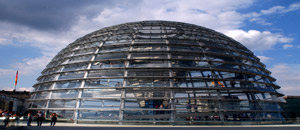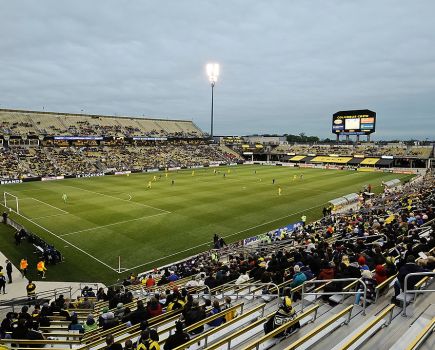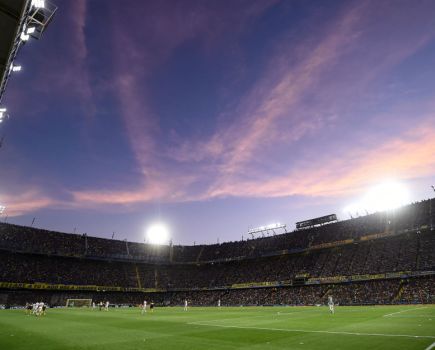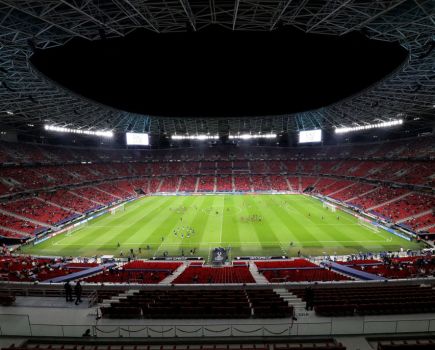BERLIN
 Berlin was the global footballing capital in 2006 when it hosted the World Cup Final, and the city’s Hertha club have been in the top flight for the past 10 years.
Berlin was the global footballing capital in 2006 when it hosted the World Cup Final, and the city’s Hertha club have been in the top flight for the past 10 years.
Hertha are based at the World Cup Final venue, built for the 1936 Olympics and renovated for last year, and their healthy league form has led to numerous appearances in Europe. They made a bright start to the current campaign and the visit of title favourites Bayern Munich on December 15 should be the game of the season at the old stadium.
But football in Berlin hasn’t always been glamour and glitz; in the Cold War years it was darkened by physical division, corruption and financial troubles.
Berlin was in the vanguard of German football – a representative side met one from Hamburg in Germany’s first inter-city match in 1896 and Berlin clubs Union 92 and Viktoria 89 won three national titles in total between 1905 and 1911. In the days before the Bundesliga, the German title was decided by means of regional championships and play-offs. Hertha, formed by a merger of the Berliner Sport-Club and Hertha Berliner Sport Club in 1920, reached the championship Final six seasons running in the 1920s and 1930s, winning two of them.
The club were based in the working-class district of Wedding, by Prenzlauer Berg – precisely where the Berlin Wall would be erected in 1961. The division between East and West had already created confusion in the immediate post-war period as the Allies and Soviets occupied different sectors of the city. Hertha were forbidden to play teams in what would become East Germany. These would form the Oberliga Berlin, merged into the new DDR-Liga in 1950-51.
Hertha’s cross-city rivals became Tennis Borussia Berlin, based at the Mommsenstadion in Charlottenburg near the Olympic stadium. Hertha moved into the main venue as one of the founders of the new West German national league, the Bundesliga, in 1963. Two years later it emerged Hertha had had to bribe players to join them in a paranoid, divided and unattractive city. The West German FA, keen to keep West Berlin in the football family, made a point of using the Olympiastadion to stage national cup finals and internationals.
Meanwhile in the East a new force was emerging. After modest success in the 1950s as SC Dynamo, the club reformed as BFC Dynamo Berlin and came under the dubious patronage of Erich Mielke, head of the hated secret police, the Stasi. Mielke put pressure on referees to favour his team. Rumour has it that an announcement over the tannoy at an away match said: “Today we would like to welcome the players and officials of Dynamo Berlin and their referee.”
The so-called Schiebemeister, the cheating champions, won the East German title 10 seasons running, from 1979 to 1988, and in 1972 made the semi-finals of the European Cup-winners Cup, losing to Dinamo Moscow – a case of the Stasi versus the KGB. Hertha were hardly squeaky clean either, thrown out of the Bundesliga in 1971 for their part in a match-fixing scandal. They bounced back to challenge the big boys in West Germany and make the semi-finals of the UEFA Cup in the late 1970s. Around the same time, Tennis Borussia made a couple of rare appearances in the top flight.
The fall of the Wall in 1989 and German reunification did not herald an instant revival of fortunes for the Berlin clubs. Tennis Borussia battled with financial problems before being refused a licence to play in the second division. The Violets are now in the Oberliga NOFV-Nord, one of the fourth-level divisions.
Dynamo, repackaged as FC Berlin, attracted a hard-core, right-wing skinhead following. They took the name BFC Dynamo in 1998, went bankrupt in 2002 but have climbed back to settle in the same league as Tennis Borussia.
Union flirted with financial collapse while fighting to make the second division, a feat they achieved in 2001. More remarkably, they reached the German Cup Final that year, losing to Schalke, and made a brief appearance in the UEFA Cup. After three seasons in Bundesliga 2, they fell back to the fourth level but now play to respectable crowds in the Regionalliga Nord, one of Germany’s two third-level divisions.
The fact that Berlin has the fifth-largest Turkish population of any city in the world is reflected in the relative success of Turkiyemspor Berlin, a modest club of mainly Turkish immigrants playing in the same division as Tennis Borussia and Dynamo.
Hertha spent most of the Eighties in the second division and emerged as a serious force only in the mid-1990s. Their revival was backed by UFA, the audio-visual branch of the Berlin-based Bertelsmann media empire, who put Robert Schwan, the brains behind Bayern in the 1960s, in charge of the relaunch. Ten years on, Hertha may not have Bayern’s massive fan base and success but they are a fixture in the top half of the Bundesliga, playing to full houses and able to give anyone a game – even mighty Bayern themselves.
Stadiums
 The Olympiastadion, home ground of Hertha Berlin and also the national stadium, holds 76,000. It staged three games during the 1974 World Cup and six in 2006, including the Final, and hosts the German Cup Final and internationals. It is set in huge grounds built as a vast sports complex for the 1936 Olympics. The Marathon Gate with its clock tower remain in place after the recent overhaul, during which the pitch was lowered, roof extended and lighting upgraded.
The Olympiastadion, home ground of Hertha Berlin and also the national stadium, holds 76,000. It staged three games during the 1974 World Cup and six in 2006, including the Final, and hosts the German Cup Final and internationals. It is set in huge grounds built as a vast sports complex for the 1936 Olympics. The Marathon Gate with its clock tower remain in place after the recent overhaul, during which the pitch was lowered, roof extended and lighting upgraded.Survival Guide
Berlin has two main airports. Schonefeld is south-east of the centre, linked by train and S-Bahn metro (20-30 minutes).
A one-way ticket (€2.70/£1.90) allows for any changes on the S-Bahn and U-Bahn lines or bus. A one-day pass is €6.30 (£4.40). Tegel airport is north-west of the centre, connected to Zoo, the main railway station in west Berlin, by X9 or 109 bus (35 mins, €2.50/£1.75). Details can be found here. The city’s main central rail station is the completely revamped Lehrter Stadtbahnhof. Berlin’s transport system is divided into zones A (city centre), B and C. A basic single ticket is €2.10 (£1.45).
Hotels
Mid-range options include the Hotel Hackescher Markt (Grosse Prasidentenstrasse 8; +49 30 280 030; €150-200/£105-£140) and the Honigmond Garden Hotel (Invalidenstrasse 122; +49 30 281 007; €125/ 58 The Artist Hotel-Pension Die Loge (Friedrichstrasse 115; +49 30 280 7513; €70/£50) and the Kunstlerheim Luise (Luisenstrasse 19; +49 30 284 480; €100/£70) are good, cheaper alternatives. For hotel booking and information, contact Berlin Tourismus Marketing (Europa-Center, Budapester Strasse, Charlottenburg; +49 1805 754040).
Eating & drinking
Prussian food is heavy and pork-laden. Sausages are ubiquitous, with wurst stands on every other corner, in a variety of sauces. For local cuisine, Gugelhof (Knaackstrasse 37; +49 30 442 9229) offers quality at reasonable prices.The Kellerrestaurant im Brecht-Haus (Chausseestrasse 125; +49 30 282 3843) serves dishes made to recipes of Helene Weigel, partner of playwright Bertolt Brecht, whose memorabilia adorns the interior. Bars worth a visit include the Mitte Bar (Oranienburger Strasse 46; +49 30 283 3837), the Anker-Klause (Kottbusser Brucke; +49 30 693 5649) and the Holst Am Zoo (Joachimsthaler Strasse 1).
Daytime entertainment
Museum Island (Museumsinsel) is home to the Pergamonmuseum (Am Kupfergraben; +49 30 2090 5577), filled with treasures from antiquity. The Reichstag (bottom picture) (Platz der Republik; +49 30 2272 2152) is another popular destination.
After dark
The landmark clubs are Tresor/Globus (Leipziger Strasse 126A) and the Kaffee Burger (Torstrasse 60).







